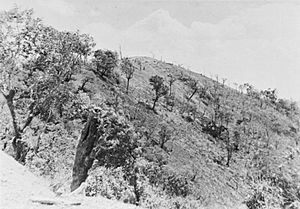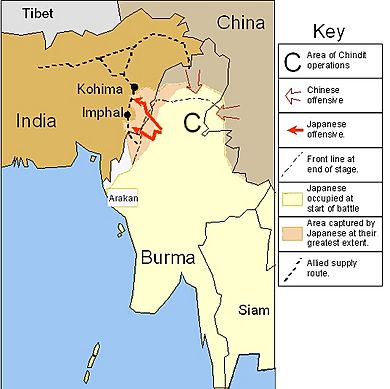Operation U-Go facts for kids
Quick facts for kids U Go offensive |
|||||||
|---|---|---|---|---|---|---|---|
| Part of the Burma Campaign in the South-East Asian theatre of World War II | |||||||
 The summit of Nippon Hill, east of Imphal, which was hotly contested during Operation U-Go |
|||||||
|
|||||||
| Belligerents | |||||||
| Commanders and leaders | |||||||
| Strength | |||||||
| 7 infantry divisions 1 tank brigade 2 infantry brigades |
5 infantry divisions 1 tank regiment 84,280 men (excluding INA) |
||||||
| Casualties and losses | |||||||
| 16,987–21,500 | 15th, 31st, and 33rd Divisions: 12,443 killed 1,652 missing in action 8,407 dead from disease Misc. Army Troops: 8,000 dead from all causes Total: 30,502 dead, 23,003 hospitalized |
||||||
The U Go offensive, also called Operation C, was a major attack by the Japanese Army during World War II. It happened in March 1944 in northeast India. The Japanese aimed to capture the towns of Imphal and Kohima. These towns were important because they were on the way to the Brahmaputra Valley. Taking this valley would cut off supplies for the British and their allies. The U Go offensive was one of the last big Japanese attacks of the war. It ended with the Battles of Imphal and Kohima, where the Japanese were stopped and then pushed back.
Contents
Why the Japanese Attacked India
In 1942, the Japanese Army had pushed British and Indian troops out of Burma. When heavy monsoon rains stopped the fighting, British and Indian forces set up in Imphal. This city was the capital of Manipur state. It was located on a flat plain, which was one of the few easy routes through the mountains between India and Burma.
For a year and a half, the Allies (British, Indian, and American forces) built up their supply routes in northeast India. The United States Army built airbases in Assam. From these bases, planes flew supplies over mountains to China. This air route was known as "the Hump". Americans also started building the Ledo road, a land route from India to China.
In mid-1943, the Japanese command in Burma changed. A new leader, Lieutenant-General Renya Mutaguchi, took charge of the Fifteenth Army. This army faced the British forces in India.
Mutaguchi's Big Plan
Mutaguchi strongly believed they should invade India. He wanted to capture Imphal and then move to the Brahmaputra Valley. This would cut off Allied supplies to their troops in northern Burma and to China. Mutaguchi felt it was his destiny to win a major battle for Japan. He was also motivated by a British special forces group called the Chindits. They had traveled through difficult terrain that Mutaguchi had once thought was impossible to cross. This made him think his own troops could do it too.
Indian National Army's Role
Subhas Chandra Bose led a group called the Azad Hind. This group wanted to free India from British rule. Bose also commanded the Indian National Army (INA). Many INA soldiers were former Indian prisoners of war. They had been captured by the Japanese after the Battle of Singapore.
Bose really wanted the INA to join the invasion of India. He convinced some Japanese leaders that a victory would cause British rule in India to collapse. The idea of a friendly government on their western border was appealing to the Japanese.
Japanese Attack Plans
The Allies were also planning their own attacks in early 1944. The Indian XV Corps was moving forward in the Arakan Province. The British IV Corps had pushed two Indian divisions close to the Chindwin River. These two divisions were far apart and could be easily cut off.
The Japanese planned a smaller attack first. This attack, called "Ha Go", would happen in the Arakan in early February. It was meant to make the Allies send their reserve troops there. This would make the Allies think the Japanese planned to attack Bengal.
Then, Mutaguchi's Fifteenth Army would launch the main attack into Manipur in early March. Their goal was to capture Imphal and Kohima. This would break up British forces and stop any Allied attacks into Burma.
Here's how the Japanese planned their main attack:
- The 33rd Infantry Division would attack Imphal from the south.
- The Yamamoto Force (a special group with tanks) would attack Imphal from the east.
- The 15th Infantry Division would go around Imphal from the north.
- The 31st Infantry Division would capture Kohima. This would cut off Imphal. Then, they would push on to capture Dimapur, a key Allied supply base.
Subhas Chandra Bose insisted that two brigades from the Indian National Army join the attacks on Imphal. The Japanese had originally planned to use the INA mainly for scouting and spreading their message.
Some Japanese leaders thought this plan was too risky. They believed it was dangerous to spread out the attacking forces so much. Mutaguchi's own division commanders were also worried. They thought he was relying too much on quick victories to solve supply problems.
Allied Defense Plans
In early 1944, the Allied forces in Assam and Arakan were part of the British Fourteenth Army. This army was led by Lieutenant General William Slim. Over the past year, Slim had worked hard to improve the health, training, and morale of his British and Indian troops. They got better supplies, fresh food, and medicines.
The Allies also learned how to fight back against Japanese tactics. The Japanese often tried to go around and trap enemy units. The Allies decided they would use aircraft to drop supplies to any units that got cut off. The Japanese did not expect this, and it helped the Allies many times.
Slim and Lieutenant General Geoffry Scoones (who led the Indian IV Corps) knew the Japanese were planning an attack. They didn't know exactly where or when. Instead of attacking first, Slim decided to let the Japanese come to them. He planned to pull his troops back into Imphal. There, they would fight a defensive battle. This way, the Japanese would have trouble supplying their own troops.
Ha Go Diversionary Attack
The smaller Japanese attack in Arakan began on February 5. Japanese troops from the 55th Division sneaked behind the Indian XV Corps. They overran an Indian headquarters and cut off the forward divisions.
However, when the Japanese attacked a fortified area called the "Admin Box", they faced a problem. Allied planes dropped supplies to the soldiers inside the box. The Japanese, on the other hand, were cut off from their own supplies and began to starve. British and Indian tanks and soldiers broke through to help the defenders of the Box. The Japanese, hungry and low on supplies, had to retreat.
U Go Main Offensive
Battle of Imphal
The main U Go offensive started on March 6, 1944. Slim and Scoones gave orders for their forward divisions to pull back, but it was almost too late. The 20th Indian Division got back safely. But the 17th Indian Division was cut off. They had to fight their way back to the Imphal plain.
Scoones had to use almost all his reserve troops to help the 17th Division. Because the Japanese attack in Arakan had failed, the Allies could fly a whole division (with its artillery and vehicles) from Arakan to Imphal. They arrived just in time to stop the Japanese 15th Division from taking Imphal from the north.
Throughout April, the Japanese attacks on Imphal's defenses were all stopped. In May, the IV Corps started to attack back. They pushed north to meet another Allied force coming south from Kohima. The Allied progress was slow. But the Japanese 15th Division had to retreat because they ran out of supplies. The Allies reopened the road between Kohima and Imphal on June 22. This ended the siege of Imphal.
Battle of Kohima
The Battle of Kohima happened in two parts. From April 3 to 16, 1944, the Japanese 31st Division tried to capture Kohima ridge. This ridge was very important because it controlled the road from Dimapur to Imphal. The troops at Imphal needed this road for supplies.
On April 16, a small British force at Kohima was rescued. From April 18 to May 16, the newly arrived Indian XXXIII Corps attacked back. They pushed the Japanese out of the positions they had captured. By the end of May, the Japanese were starving. Lieutenant General Kōtoku Satō went against Mutaguchi's orders and told his division to retreat. Even though some Japanese troops kept fighting to block the road, the XXXIII Corps pushed south. They met the defenders of Imphal on June 22.
Japanese Retreat
Mutaguchi kept ordering new attacks, but by late June, it was clear his Japanese troops were too sick and hungry to fight. When he realized none of his units were obeying his orders, Mutaguchi finally called off the offensive on July 3. The Japanese soldiers, many of them weak and disorganized, fell back to the Chindwin River. They left behind their artillery, vehicles, and any soldiers too sick to walk.
Results of the Offensive
The Japanese defeats at Kohima and Imphal were their biggest losses up to that point in the war. The British and Indian forces lost about 16,987 soldiers (dead, missing, or wounded). The Japanese suffered huge losses, with 60,643 casualties. This included 13,376 killed. Most of these Japanese losses were due to starvation, disease, and exhaustion, not from fighting.
This defeat led to big changes in the Japanese Army in Burma. Mutaguchi fired all his division commanders during the operation. Then, he himself was fired on August 30. Kawabe, whose health was poor, was also removed from his command. Many senior officers were also moved to lower positions.


